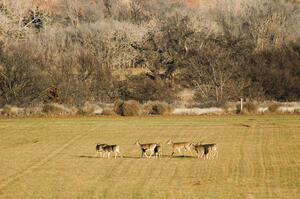Deer Damage Control Permits
This page outlines lethal control options landowners may use to address deer damage. Site-specific assistance is available from any district wildlife biologist (DWB) or natural resource officer (NRO) from the Kansas Department of Wildlife and Parks (KDWP). Permits authorizing lethal control measures and possession of a deer carcass outside normal deer hunting seasons may be issued by any DWB or NRO.
DEER MANAGEMENT GOALS
Deer are protected as a valuable public resource by state law and regulations. Provisions are authorized to allow for wise use of this resource. Deer management in Kansas is directed by long-range planning that includes input from citizens of the state as well as wildlife professionals. The goal established through this process is: “...to manage the deer population at levels consistent with existing habitat and landowner tolerance, and to provide for recreation use.”
LEGAL OBLIGATION
The Bill of Rights of the Kansas Constitution provides landowners with rights to protect their property. These rights may be applied to deer damaging crops. Both court decisions and Attorney General Opinions have shown that these rights are not without limitations. The landowner must demonstrate that deer are causing substantial damage to property. KDWP staff will consider any visible current deer damage to be substantial in this context.
Regulation K.A.R. 115-16-4 authorizes the Secretary of Wildlife and Parks to issue deer control permits. This regulation provides landowners with a legal means of controlling deer and using the meat of deer that are killed during this operation. The permits are intended to address localized problems. DWBs and COs are responsible for working with landowners in implementing the use of deer damage control permits.
OBTAINING DEER CONTROL PERMITS
- The landowner contacts the nearest KDWP office. A KDWP staff member will contact the landowner within five working days of notification of a deerdamage situation.
- The damage area will be inspected by the landowner and DWB or CO.
- If control permits are needed, an application will be prepared and damage control permits will be issued quickly.
- Each deer damage control permit is written for a specific case. When authorized, the permits will allow the landowner to kill a prescribed number of deer on the property.
- Taking antlerless deer will be emphasized during control operations.
- Permits and possession tags will be assigned to the landowner and the landowner will be responsible for the control operation.
- The landowner may issue the permits, without cost, to a designated person(s), who may act as the control agent.
- A designated agent must be a Kansas resident and must have a Kansas hunting license, unless exempt.
- Landowners will be required to follow prescribed procedures and to report on the results of their control efforts.
-
As a condition for receiving deer damage control permits, the landowner must agree to allow firearms deer hunting on their property during that year’s regular
or extended firearms deer season. - Hunter access to the landowner’s property is at the landowner’s discretion and by landowner permission.
DAMAGE CONTROL PERMITS WILL NOTSOLVE ALL PROBLEMS
A deer damage control permit is not the answer to all situations where landowners are experiencing damage. Some situations will continue to attract deer, even when many have been removed. Certain high-value crops, such as orchards and nurseries, may not be effectively protected using firearms and damage control permits. Fencing to exclude deer from these areas may be more cost effective than attempting to shoot deer as they enter the area.
DEVELOPING A MANAGEMENT PLAN
The most effective and efficient means for controlling excessive deer populations and the resulting damage they cause is through harvesting deer during established hunting seasons. This approach can place sufficient hunters in the field to harvest deer over a wide area. Regulation of permit numbers and permit types available to hunters ensures that sustained harvests will occur; however, local deer populations still may develop that detrimentally affect some agricultural producers. Deer control permits may be used to address these situations.
Deer population growth is influenced by the number of does in the population and the quality of the habitat available to them. The KDWP stresses the importance of harvesting antlerless deer in order to regulate the growth of the population.
Landowners are encouraged to cooperate with regular hunting season efforts to control deer populations, encouraging neighbors to allow a sufficient harvest on their lands. Allow legal hunters permission to hunt on your property, and encourage hunters to take antlerless deer in areas that are experiencing crop damage. Occasionally deer move substantial distances (5-15 miles) between the croplands they use in the summer and heavy cover they use in the winter. Therefore, it is necessary for landowners to work together in addressing deer damage problems. KDWP staff is available for consultation regarding the need for such cooperation.
For further information concerning deer damage control permits and other control measures, contact your local District Wildlife Biologist, Conservation Officer, or a KDWP office near you ( Locations ).








